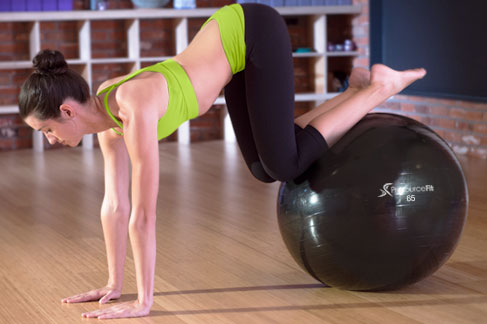How to Use a Stability Ball: 7 Exercises to Tone Your Entire Body
What Are Stability Exercise Balls?
Stability balls, originally created for neurodevelopment and physical therapy, can now be found in almost any gym, Pilates studio, or sporting goods store. Known by many names - Swiss balls, physio balls, balance balls, or yoga balls – fitness balls are used to improve posture, strengthen the core, improve balance and proprioception, and increase lower back mobility.
They are also very effective for rehabilitation exercises, senior fitness, and improving overall body awareness for injury prevention.
Why Should You Use an Exercise Ball?
For the everyday gym goer, a stability ball is a multi-functional piece of exercise equipment that can help you reap more rewards in the same amount of time from your workouts.
When using a Stability Exercise Ball, your body requires the use of more muscles, particularly the core muscles, to stabilize and balance your body. This means that if you move your normal exercises like a chest press, shoulder press, or crunches to a stability ball, you may get a more effective workout. Without having to do tons of sit-ups, you’ll engage your core muscles while you’re emphasizing your other muscle groups.
What Size Gym Ball Should You Get?
Stability balls typically come in three sizes – 55mm, 65mm, 75mm. Choosing the right size depends on your height. It is recommended to use a ball that, when seated on it with feet flat on the floor, the user’s knees and hips are bent at 90 degrees.
Here’s a general guide to use when purchasing a ball:
4’8” to 5’5” – 55mm
5’6” to 5’11” – 65mm
6’0” to 6’5” – 75mm
Be sure that the ball is fully inflated so that it is firm. If the ball feels squishy or has too much give, be sure to pump it up before using.
What Exercises Can You Do with a Stability Ball?
Fitness balls can be used for a variety of exercises, including abs, back, chest, arms, and legs. It can be used in place of a bench at the gym when using lighter dumbbells; it can also serve as a great way to learn how to squat, or you can perform most of your usual floor ab exercises on the ball instead.
Here are 7 exercises to get started that will hit your entire body. You can add in one or two of these exercises to your current routine, or use this series as a full-body workout, repeating 2-3 times per week.
Forearm Plank
- Rest your forearms on the ball with legs extended behind you, like a push-up position. Elbows should be aligned underneath shoulders, and shoulders should be drawn down away from ears.
- Keep body in one straight line with core tight and hips not sinking or raised up in the air.
- Hold this position for 30-60 seconds.
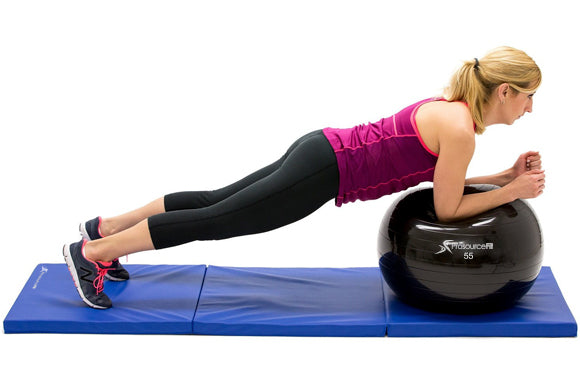
Ball Pass
- Lie on your back, legs extended straight out on the floor, and arms extended fully back behind you, holding the stability exercise ball.
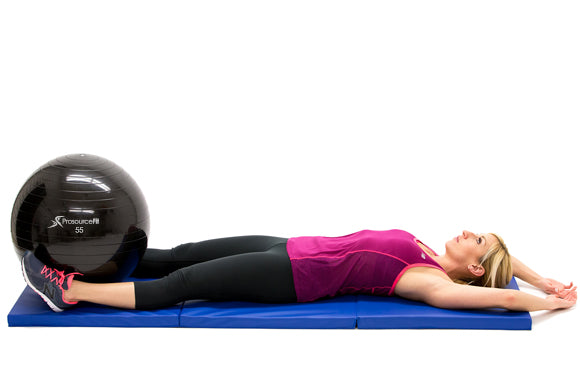
- Engage your core, then simultaneously lift your arms and legs off the ground, reaching toward each other.
- Pass the ball from your arms to between your feet, and squeeze ball with legs to keep it in place.
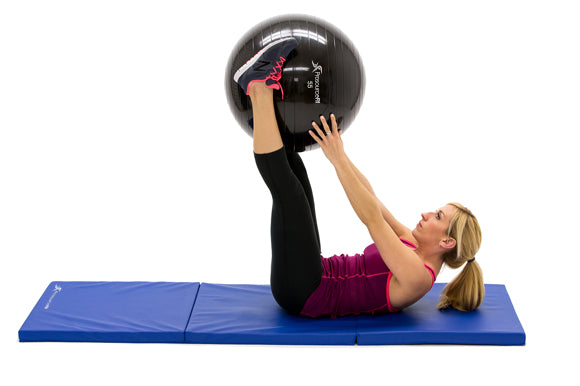
- Lower arms and legs back to the floor. Repeat, passing the ball back to your hands. That completes one rep.
- Perform 8-10 reps.

Ball Crunch
- Sit on top of the Stability Exercise Ball, then slowly walk your feet out while lowering your upper body until your lower back and top of your buttocks are resting on the ball. Feet should be out in front of you, flat on the floor, knees bent at 90 degrees. Let upper body rest back on the ball.
- Place hands behind neck for support (but do not pull your head forward during the crunch). Tighten your core, and exhale as you crunch up until your body is at approximately 45 degrees.


- Pause for a second, then slowly return to the start, allowing your back to extend across the ball for a full range of motion.
Ball Squat
- Place stability ball against a wall and lean against it so that your back and hips are supported. Step feet about 6 - 12 inches in front of your body, feet approximately shoulder distance apart with toes facing forward or turned out slightly.
- Pull your shoulders blades back and down. Gently lean into the ball as you bend knees and sit down into a squat position.
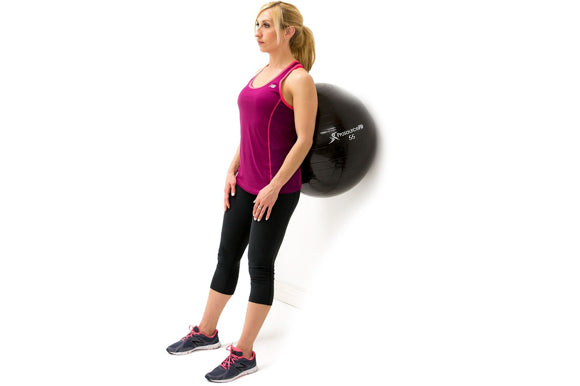
- Keep your weight in heels, and keep pressing lower back against the ball. Set hands lightly on the front of your thighs or hips.
- When legs are bent at 90 degrees and thighs are parallel to the floor, press back up to the start, maintaining the same body position and a tight core.
- Repeat 12-15 times.

Hamstring Curl
- Lie on your back on the floor with the stability ball in front of you, arms extended by your sides on the floor. Place both heels on top of the ball with legs straight.
- With arm supporting you, press through your heels and lift hips up into the air, so your body forms a straight diagonal line from feet to shoulders.


- Draw heels in toward your buttocks, bringing the ball as close to your body as possible. Hold and squeeze for a moment, then return to start position. Do not drop buttocks back down to the mat. Repeat 10-12 times.
Dumbbell Chest Press
- Sit on the stability ball with a pair of dumbbells in your hands, then slowly walk your feet out while leaning backward until your upper back and neck are supported on the ball.
- Your feet flat should be flat on the floor, knees bent with ankles directly under your knees. Lift your hips and engage your core.
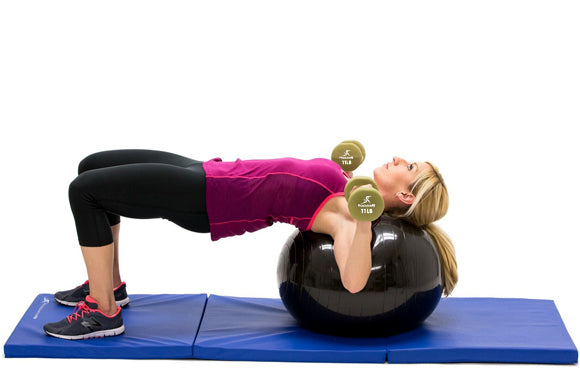
- Holding the dumbbells by your chest, palms facing forward, exhale as you press the weights toward the ceiling, squeezing your chest muscles as the weights come together over your chest.
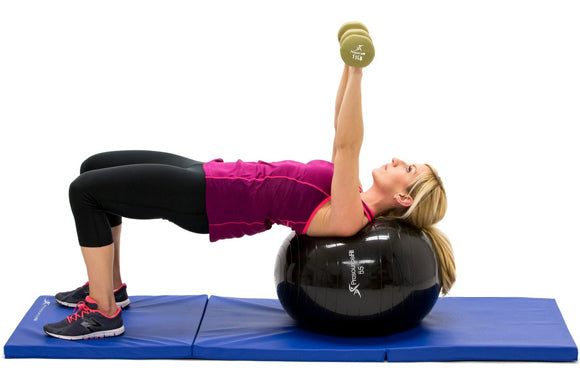
Dumbbell Wide Row
- Lie on an exercise ball in a prone position (toward the floor) with your hips and abdomen pressing against the ball. Place bottoms of feet against a floor behind you to help keep you balanced. Make sure to keep core pulled in tight throughout the exercise.
- Hold a dumbbell in each hand, palms facing the wall behind you. Slightly lift chest and shoulders to prepare for the exercise. Maintain this body position throughout the exercise.
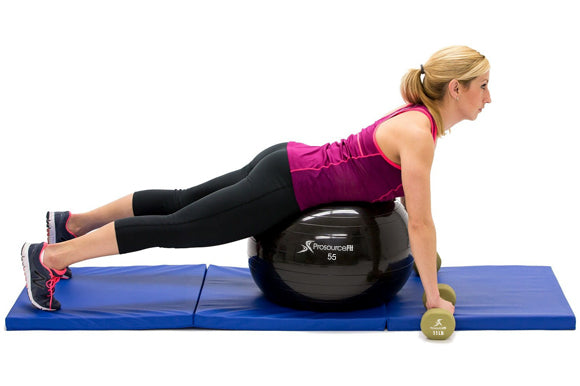
- Squeezing your shoulder blades together, draw both arms up, maintaining a 90-degree angle at the elbows. Pause as you contract your back muscles at the top, then slowly lower weights back toward floor.
- Repeat 10-12 times.
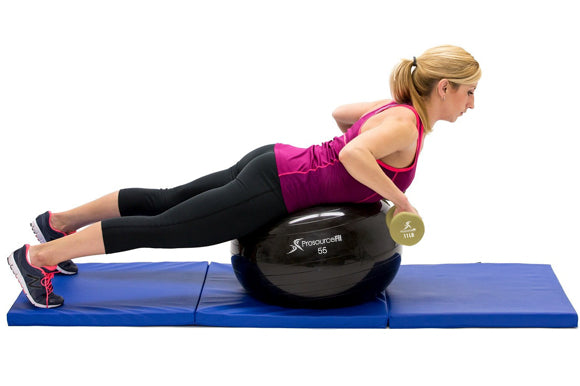
Sources:
https://www.ncbi.nlm.nih.gov/pubmed/17530978
http://www.spine-health.com/treatment/physical-therapy/exercise-ball-therapy-lower-back-pain-relief
http://www.coreperformance.com/knowledge/training/stability-ball-training-101.html

